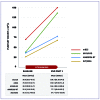Eltrombopag for the treatment of inherited thrombocytopenias: a phase II clinical trial
- PMID: 31273088
- PMCID: PMC7049343
- DOI: 10.3324/haematol.2019.223966
Eltrombopag for the treatment of inherited thrombocytopenias: a phase II clinical trial
Abstract
Patients with inherited thrombocytopenias often require platelet transfusions to raise their platelet count before surgery or other invasive procedures; moreover, subjects with clinically significant spontaneous bleeding may benefit from an enduring improvement of thrombocytopenia. The hypothesis that thrombopoietin-mimetics can increase platelet count in inherited thrombocytopenias is appealing, but evidence is scarce. We conducted a prospective, phase II clinical trial to investigate the efficacy of the oral thrombopoietin-mimetic eltrombopag in different forms of inherited thrombocytopenia. We enrolled 24 patients affected by MYH9-related disease, ANKRD26-related thrombocytopenia, X-linked thrombocytopenia/ Wiskott-Aldrich syndrome, monoallelic Bernard-Soulier syndrome, or ITGB3-related thrombocytopenia. The average pre-treatment platelet count was 40.4 ×109/L. Patients received a 3- to 6-week course of eltrombopag in a dose-escalated manner. Of 23 patients evaluable for response, 11 (47.8%) achieved a major response (platelet count >100 ×109/L), ten (43.5%) had a minor response (platelet count at least twice the baseline value), and two patients (8.7%) did not respond. The average increase of platelet count compared to baseline was 64.5 ×109/L (P<0.001). Four patients with clinically significant spontaneous bleeding entered a program of long-term eltrombopag administration (16 additional weeks): all of them obtained remission of mucosal hemorrhages, with the remission persisting throughout the treatment period. Treatment was globally well tolerated: five patients reported mild adverse events and one patient a moderate adverse event. In conclusion, eltrombopag was safe and effective in increasing platelet count and reducing bleeding symptoms in different forms of inherited thrombocytopenia. Despite these encouraging results, caution is recommended when using thrombopoietinmimetics in inherited thrombocytopenias predisposing to leukemia. ClinicalTrials.gov identifier: NCT02422394.
Copyright© 2020 Ferrata Storti Foundation.
Figures


Comment in
-
Thrombopoietin receptor agonists for the treatment of inherited thrombocytopenia.Haematologica. 2020 Mar;105(3):536-538. doi: 10.3324/haematol.2019.241786. Haematologica. 2020. PMID: 32115414 Free PMC article. No abstract available.
References
-
- Balduini CL, Pecci A, Noris P. Diagnosis and management of inherited thrombocytopenias. Semin Thromb Hemost. 2013; 39(2): 161–171. - PubMed
-
- Dupuis A, Gachet C. Inherited platelet disorders: management of the bleeding risk. Transfus Clin Biol. 2018; 25(3):228–235. - PubMed
-
- Estcourt LJ, Birchall J, Allard S, et al. Guidelines for the use of platelet transfusions. Br J Haematol. 2017; 176(3):365–394. - PubMed
-
- Kaufman RM, Djulbegovic B, Gernsheimer T, et al. Platelet transfusion: a clinical prac-tice guideline from the AABB. Ann Intern Med. 2015; 162(3):205–213. - PubMed
Publication types
MeSH terms
Substances
Associated data
LinkOut - more resources
Full Text Sources
Medical
Miscellaneous

